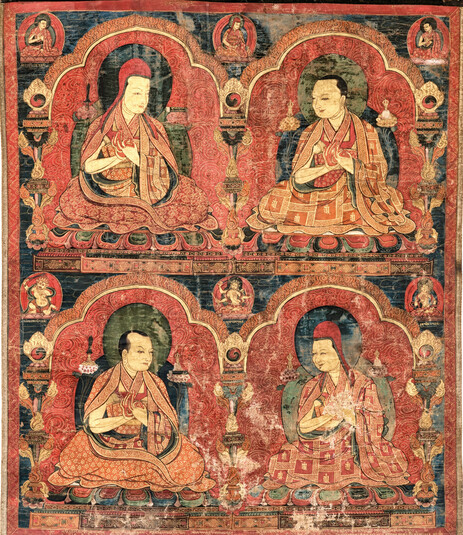
Item: Teacher (Lama) - (multiple figures)
| Origin Location | Tibet |
|---|---|
| Date Range | 1500 - 1599 |
| Lineages | Sakya, Ngor (Sakya) and Buddhist |
| Material | Ground Mineral Pigment on Cotton |
| Collection | Private |
Classification: Person
Muchen Sempa Chenpo Konchog Gyaltsen (1388-1469), Jamyang Sherab Gyatso (1396-1474), Gyaltsab Kunga Wangchuk (1424-1478) and Gorampa Sonam Sengge (1424-1489).
A Ngor Lamdre Lineage Painting Central Tibet, circa 1525
Four distinguished human figures command this composition, which is the second to last painting in an important set of nine paintings depicting the Lamdre (Skt. Margapala), or ‘Path and Fruit’, lineage holders of Ngor Monastery of Tsang Province (south-central), Tibet. This is a line of transmission of meditation teachings, based primarily on the Hevajra cycle of tantras, of which there are many variations particular to the subschool of Sakya.
Ngor Monastery is one of the most influential sub-divisions of the Sakya tradition of Tibetan Buddhism and can be credited with patronizing some of the most outstanding, complex, and highest quality works of Tibetan art. Moreover, the monastery continued to patronize a distinct aesthetic, with pronounced Beri (‘Nepalse Style’) influence through the sixteenth century. This painting set is an example of that style: composed in registers, rich in red, and filled with foliate designs in the negative space throughout. These stylistic elements are typical for fifteenth- and sixteenth-century Sakya and Ngor paintings and wall murals, such as those within the Gyantse Kubum--a collection of murals which had great artistic influence on Tibetan art of this period. For another fifteenth- or sixteenth-century Sakya painting set of Lamdre lineage holders, see Philadelphia Museum of Art accession nos. 1970-198-1, 1994-148-639 and 1970-198-2, which bears a close stylistic similarity to this.
The present painting’s lineage holders are identifiable by poetic verses of praise that line the bottom register. The figures depicted are the second abbott of Ngor, Muchen Sempa Chenpo Konchog Gyaltsen (1388-1469); the third abbott, Jamyang Sherab Gyatso (1396-1474); the fourth abbot, Gyaltsab Kunga Wangchuk (1424-1478); and the sixth abbott, Gorampa Sonam Sengge (1424-1489). The deities floating between registers can be identified as Achala, Manjushri, and Vajravidarana.
While the fifth abbot, Khedrup Palden Dorje (1478-1482), is missing from this painting, this is not the only instance in which this Ngor Lamdre lineage is presented without him. Another Lamdre lineage painting depicting Kunga Wangchug and Gorampa Sonam Sengge as the main two figures (see Himalayan Art Resources, item. No 30518) also omits the fifth abbott. Moreover, the one remaining inscription under the top three floating figures in the present composition could be Palden Dorje. However, the inscription is abraded at the center and it is therefore impossible to be sure.
The other four known paintings from this set are the third, fourth, fifth, and eight in the sequence (Himalayan Art Resources, item no.’s 30804, 30922, 30923, and 44402). The first in this set would depict the primordial buddha Vajradhara, and as hanging tradition goes, the second painting would be placed to the proper-right of Vajradhara, the third to the proper-left, and so forth. Although the painting depicting following two lineage holders (seventh abbott, Konchog Pelwa, and eighth abbott, Muchen Sanggye Rinchen) contains other elements indicating that it is the final painting in the sequence--Panjarnata Mahakala and Vaishravana standing as the lower two primary figures, as well as a donor figure in the lower left--is it likely that, for the sake of symmetry, a ninth painting was included as the fourth painting on the left. This final painting would depict additional deities chosen by the patron or artist. As such, the present painting, would be hung third from center on the proper-left of the buddha Vajradhara.
This important painting set can be roughly dated to 1525 based on the death date of the last lineage holder depicted in the set, the eighth abbot of Ngor Monastery, Muchen Sanggye Rinchen (b.1450). Two of these early-sixteenth-century works, were formerly in a renowned Swiss collection, and sold at Galerie Koller, Zürich, 26 June 1993, lots 109 and 110. All four known examples are now in private collections.
Laura A. Weinstein 9-2020
Inscription translation:
Endowed with the highest aspiration of the virtuous [three] jewels, Extraordinary victor of all directions, With auspicious signs, virtuous qualities, and goodness, I bow at the feet of Sempa Chenpo.
Having unobstructed all knowable things, Having impressed on the mind an ocean of scripture, [His] magnificent renown pervades all three realms, I bow at the feet of Jamyang Choje.
Beholding the essential nature of all tantras, [He] extends the celebration of the ripened and free in all ten directions, I bow [at the feet of] Khyenrab Wangchuk, excellent guide of fortunate students.
Having fully developed immeasurable merits, Senge’s clear roar frightens every beast of falsehood with Sugata’s teachings, I bow [at the feet of] the snow mountain preserver of Buddhist teachings.
Auspiciousness!
Tibetan:
dkon mchog dge pa'i lhag bsam can/ mi 'thun phyogs las rnam rgyal ba/ dge mtshan dpal yon bzang pa can/ sems dpa’ chen po'i zhabs la 'dud/
shes bya kun la thogs med cing/ gsung rab rgya [mtsho] thugs su chud/ grags pa'i dpal gyis sa gsum khyab/ 'jam dbyangs chos rje'i zhabs la 'dud/
rgyud sde kun gyi de nyid gzigs/ smin grol dga' ston phyogs bcur 'gyang/ mkhyen rab dbang phyug gdul bya yi/ 'dren pa dam pa de la 'dud//
rgya chen bsod nams lus stobs rab rgyas shing// bde gshegs gsung rab seng ge'i nga ro yi// log smra'i ri dags mtha’ dag skrag mdzad cing// thub bstan gangs ri skyongs ba de la 'dud/
mang+ga laM
Laura A. Weinstein 9-2020
Painting Set: Margapala [17]
Collection: Christie's, London (Painting. November, 2020)


